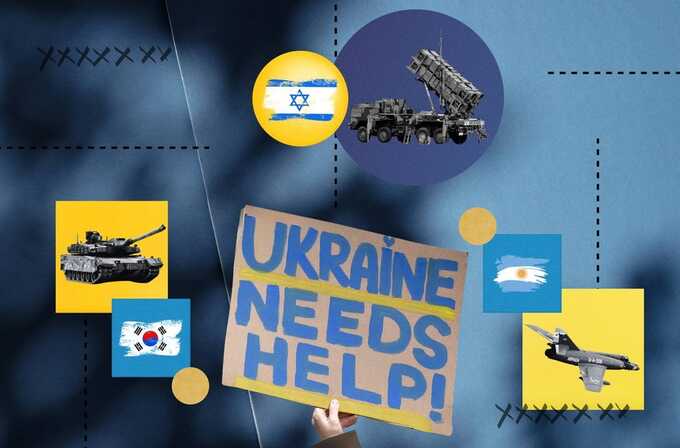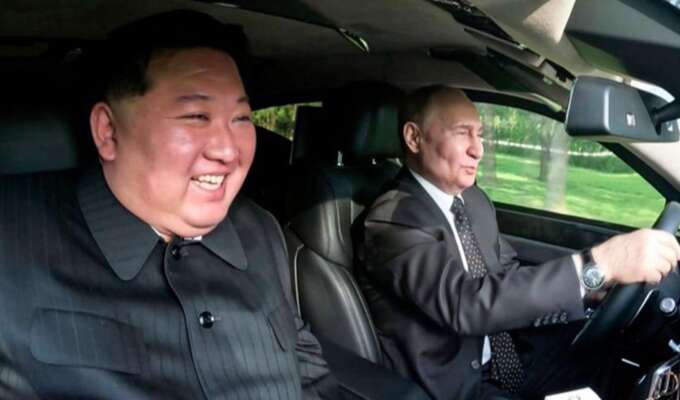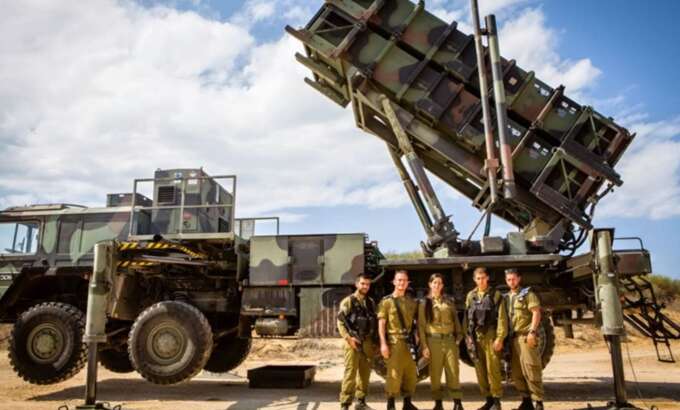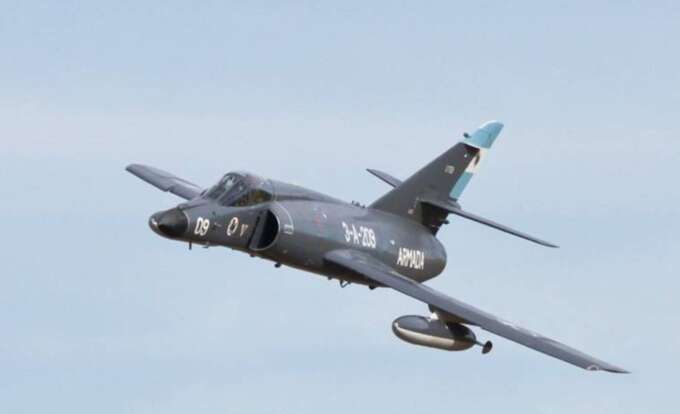New blood: How the Kremlin’s aggressive ambitions are bringing Ukraine more allies worldwide

At the outset of Putin’s full-scale invasion of Ukraine, Kyiv found it difficult to seek military assistance from third countries.
Its first supporters were mainly European countries and the United States, but as it soon turned out, the amount of weapons these Western powers were able to transfer was quite limited. Paradoxically, Vladimir Putin came to the rescue: by provoking conflicts in Asia, the Middle East, and Latin America, Putin worsened Russia’s relations with several neutral countries to such an extent that they have begun discussions with Ukraine regarding military aid. As a result, Kyiv may now hope to obtain Israeli batteries of the Patriot air defense system, South Korean tanks and infantry fighting vehicles, and Argentine armored vehicles and artillery pieces.
South Korea: Putin’s visit to Kim changes the tone
South Korea has supported Ukraine since the beginning of the full-scale Russian-Ukrainian war. Seoul joined the international sanctions coalition and imposed multiple separate restrictions in response to North Korean munitions shipments to Russia and Russian oil shipments to the DPRK. South Korea provides humanitarian and financial aid to Kyiv, but has so far refused to supply the Armed Forces of Ukraine (AFU) with lethal weapons, seeking to maintain relations with Russia no matter what. However, it was South Korea that transferred hundreds of thousands of artillery rounds to their U.S. allies, which allowed the U.S., in turn, to send ammunition to Ukraine from its own stockpiles.
South Korea provides humanitarian and financial aid to Ukraine but has so far refused to supply the AFU with lethal weapons directly
The situation changed after Vladimir Putin’s visit to Pyongyang and the signing of the Russian-North Korean strategic partnership agreement. In response, Seoul threatened to reconsider its position on arms deliveries to Kyiv, and soon drew a red line, promising to deliver its “entire arsenal” to Ukraine if Russia transferred precision weapons or relevant technologies to the DPRK.

While the scope of potential deliveries is unclear, Seoul has at its disposal many weapons that can be transferred immediately and a powerful defense industry capable of meeting orders for a wide variety of arms and ammunition not readily in stock.
Here is what South Korea already has. First of all, Ukraine could use Soviet T-80U tanks and BMP-3 infantry fighting vehicles, which Russia delivered to the Republic of Korea in the 1990s as repayment of its foreign debt. In 2022, the AFU managed to capture a large number of these vehicles (44 tanks and 53 IFVs, according to Oryx), so the Ukrainian military should have experience handling them. The South Korean fleet of T-80Us and BMP-3s could also serve as a source of spare parts for the AFU’s captured stocks.
In addition, Seoul may provide Kyiv with artillery ammunition and air defense equipment, such as Chiron man-portable air defense systems (reports about the transfer of these systems to Ukraine have surfaced before but were never confirmed).

T-80U tanks in service with the South Korean army
Korea Defense Blog / FB
As a country with one of the world’s largest military-industrial complexes, South Korea can also produce its own weapons, expanding its already sizeable arsenal. South Korean companies are fulfilling large-scale long-term contracts to supply Poland and Romania with K2 Black Panther tanks, K9 Thunder self-propelled howitzers, and FA-50 combat trainer aircraft. Most likely, the production lines are already loaded with orders, but with consent from other customers, priority may be given to Ukraine, as the U.S. has already done with surface-to-air missiles for NASAMS and Patriot systems.
South Korea also produces its own surface-to-air missile systems, in particular, Cheongung-II, which was developed with technical support from Russian companies Almaz-Antey and MKB Fakel. The missile system is reputed to possess good anti-missile capabilities — on par with the Patriot or the French-Italian SAMP/T. Although South Korea needs to strengthen its own air defense due to the DPRK missile threat, Seoul already produces such systems for Saudi Arabia and the United Arab Emirates. The delivery of even one or two batteries to Ukraine would considerably boost the defense of its strategic facilities against Russian missile attacks.
Even two South Korean air defense batteries would considerably boost the defense of Ukraine’s strategic facilities from Russian missile strikes
Considering that Russia still needs North Korean munitions to sustain its war effort and that Moscow may soon also request Soviet-legacy armored vehicles from the DPRK, we can assume that sooner or later South Korea will have to bring its threats to life.
Israel: Russian support for Hamas has not gone unnoticed
For a long time, Israeli Prime Minister Benjamin Netanyahu maintained friendly relations with Russia — despite the annexation of Crimea and the hybrid war Russia waged against Ukraine in the Donbas. Netanyahu used his personal acquaintance with Vladimir Putin — and with Donald Trump — in his 2019 election campaign and traveled to Moscow for the Victory Day parade in 2018. Putin, in turn, spoke at an Israeli Holocaust remembrance forum in 2020.
Russia and Israel also reached a certain mutual understanding on the war in Syria: Russian air defenses did not react to Israeli strikes against Iran’s Islamic Revolutionary Guard Corps and Hezbollah facilities on Syrian territory, and Russian aircraft had free access to the air space over the Israeli-controlled Golan Heights for use in strikes on rebel-controlled areas of southern Syria. Even when Russian-origin weapons occasionally surfaced in the hands of Hamas militants, the unspoken alliance held.
Russian air defenses did not interfere with Israeli strikes on targets in Syria, and Russian aircraft had free access to the air space over the Golan Heights
Israel’s large Russian-speaking population is mostly pro-Ukrainian. Nevertheless, after the start of Russia’s full-scale Russian invasion, Israel was among the countries that refused to provide direct military aid to Kyiv. Netanyahu was in the opposition at the time, and Israel’s then-Prime Minister Naftali Bennett attempted to mediate peace talks between Kyiv and Moscow while refusing to authorize the supply of Israeli-made weapons from third countries to the AFU. Netanyahu’s return to the prime minister’s office did not change the situation, and Israel has thus far limited its help to Ukraine to the deployment of a missile warning system.
However, Russian-Israeli relations deteriorated sharply when Israel’s war with Hamas began in October 2023. The Russian leadership took an openly pro-Hamas stance and hosted the group’s delegations in Moscow. Some members of Israel’s ruling Likud party warned the Kremlin of potential payback for its support of Hamas (even if their threats were mostly rhetorical). In addition, the Israeli leadership has to be concerned about the strengthening cooperation between Moscow and Tehran (The Insider wrote more about this dynamic in a piece on the dictatorships supporting the Kremlin in its war with Ukraine).
At first glance, Israel is hardly in a position to significantly help Ukraine now: the fighting in the Gaza Strip has not stopped, and a large-scale operation against Hezbollah in southern Lebanon may soon begin. However, even in this situation, the IDF arsenals contain equipment that is in high demand for the AFU. First of all, it could supply Patriot systems, which Israel is removing from service in favor of more modern alternatives. In June, it became known that Ukraine, Israel, and the United States were negotiating the transfer of these Patriots to Kyiv.

A launcher from the Patriot system in service with the IDF
Israel Defense Forces
With time, Israel may even give the green light to supplying Ukraine with more advanced air defense systems, including the famous Iron Dome, which is produced in the United States according to an Israeli design. Despite the rather limited range of the missiles, they cost significantly less than surface-to-air missiles for the Patriot, and the system is definitely suitable for protecting frontline cities, such as Kharkiv and Kherson, from rocket attacks and drone strikes.
Another Israeli weapon that could likely be transferred to Ukraine by third countries is the Spike family of anti-tank missile systems. Israel may also grant Ukraine or its partners a license to produce reconnaissance drones, following the precedent set with Russia, which produced such drones under the names Zastava and Forpost.
Israeli RADA ieMHR tactical radars have already been spotted in use by the Ukrainian military. So far, however, Israel has neither supplied Kyiv with its lethal weapons nor allowed third countries to do so.
Argentina: choosing the U.S. over Russia
Unlike the Republic of Korea and Israel, Argentina’s changing position on the Russia-Ukraine conflict is not directly related to the Kremlin’s activities. Putin even congratulated new President Javier Milei on his election and said he looked forward to strengthening the partnership between Moscow and Buenos Aires. However, Milei adopted a course of North Atlantic integration in his foreign policy — in opposition to his Peronist opponents. Despite performative statements about the British Falkland Islands belonging to Argentina, the rhetoric of the Milei government is largely aimed at rapprochement with the U.S. and other Western countries. In a sense, Putin has become hostage to his own propaganda: over the past few years, the Kremlin has placed such great emphasis on Russia’s confrontation with the U.S. that countries in Latin America (and elsewhere) have little choice but to pick a side. As a result of Russian rhetoric, any Latin American leader who wants to get closer to the U.S. will all but automatically identify as an opponent of the Kremlin.
As part of its new policy, Buenos Aires has already announced the transfer of Mi-17 helicopters, which it previously purchased from Russia, to Ukraine. There are also plans to supply the AFU with Dassault-Breguet Super Étendard carrier-borne strike fighter aircraft, which Argentina cannot use anyway due to a British embargo on arms and spare parts.

One of Argentina’s Dassault-Breguet Super Étendard carrier-borne strike fighter jets
Ministerio de Defensa / Armada Argentina
Argentina’s capacity for military assistance to Ukraine extends beyond aircraft. Other items of interest include more than 200 TAM medium tanks, which are currently undergoing modernization but have not yet been tested in combat, along with a separate line of vehicles derived from their design, including IFVs, self-propelled howitzers, anti-aircraft guns, and armored recovery vehicles. In addition, Argentina possesses American M113 armored personnel carriers and HMMWV armored vehicles, Italian OTO Melara Mod 56 pack howitzers, and Swedish RBS 70 man-portable air-defense systems, which are already used by the AFU.
Despite Milei’s tense relations with Brazilian socialist president Lula da Silva, a major military conflict between Argentina and any of its neighbors is highly unlikely. Therefore, Argentina could agree to transfer some of its existing equipment to Ukraine, especially if it could then order new replacements from the U.S. and other NATO countries, thus strengthening its cooperation with the West.
Other “swing states”
Several more countries could provide direct military assistance to Ukraine but have not done so for various reasons.
For instance, early in 2024, Japan became Ukraine’s largest financial donor under the framework of international budget support mechanisms. Legislative restrictions once imposed to prevent a «revival of Japanese militarism” now prevent direct military aid, but Japan has already lifted some of them. In the future, this will allow Japan to supply the U.S. with Japanese-made PAC-3 interceptor missiles for Patriot systems in order to replace those supplied to Ukraine. A similar scheme could be used to supply 155mm artillery ammunition, although the attempt to reach such a deal with the UK failed.
Another country that supplies Ukraine with ammunition through unnamed intermediaries is India. Indian-made 155-mm artillery and 125-mm tank rounds make regular appearances in AFU stocks (1, 2, 3). Officially, Indian authorities deny the existence of arms shipments to Ukraine, but they are willing to look past the purchase and resale of ammunition by third countries. What adds ambiguity to the situation is that the AFU is simultaneously receiving ammunition produced by Pakistan, India’s inexorable adversary.
Officially, Indian authorities deny supplies to Ukraine, but they are willing to look past the purchase and resale of ammunition by third countries
Hypothetically, India could expand the range of supplies: in particular, New Delhi plans to replace more than 2,000 BMP-2 infantry fighting vehicles with American Stryker armored fighting vehicles. The Soviet-designed BMP-2 vehicles would be very useful to the AFU, especially in such quantities, although they are significantly inferior to the American Bradley armored fighting vehicles. Still, supplies from the arsenal of the Indian Army are unlikely to find their way directly to Ukraine due to the policies of current Prime Minister Narendra Modi, who is anxious to maintain good relations with Russia despite its partnership with China, India’s other strategic rival.
Moreover, India still counts on Russian supplies of various weapons, including warships. But there have been disruptions to the supply of Russian weapons. In particular, Moscow failed to hand over a batch of S-400 SAM systems on time due to losses incurred by Russian air defense assets in the war with Ukraine.
Countries supplying arms to Ukraine risk the Kremlin’s retaliation. One such precedent involves Ecuador, which planned to transfer Soviet helicopters and air defense systems to Ukraine via the U.S. in exchange for American weapons — until the Russian agricultural regulator banned the import of Ecuadorian bananas “for sanitary reasons.” Notably, concerns about the quality and cleanliness of Ecuador’s fruit immediately disappeared just as soon as the country refused to supply the weapons in question.
In a similar case, ammunition for Ukraine obtained under the Czech-led initiative has to be procured in the strictest secrecy in order to prevent Russia from disrupting transfers by pressuring potential suppliers.
However, some countries’ reluctance to help Ukraine is explained not by Russian influence or threats, but by their apprehension of the U.S. and the military-political bloc led by Washington. For example, Brazilian President Lula da Silva is known for his ambiguous statements about the Russian-Ukrainian conflict. Despite the diplomatic efforts of French President Emmanuel Macron, Lula refused to attend the peace summit organized by Ukraine in Switzerland this past June. Nevertheless, Brazil could offer Ukraine Super Tucano turboprop aircraft that would be efficient against Russian loitering munitions and reconnaissance drones — or at least allow the re-export of these aircraft.
In other words, the world still has considerable unused resources for military aid to Ukraine. Whether they will find their way into the hands of the AFU depends on the diplomatic efforts applied by Kyiv and its international partners, who should offer potential arms suppliers favorable conditions — including protection against possible Russian retaliation.
Read more similar news:
Comments:
comments powered by Disqus

































